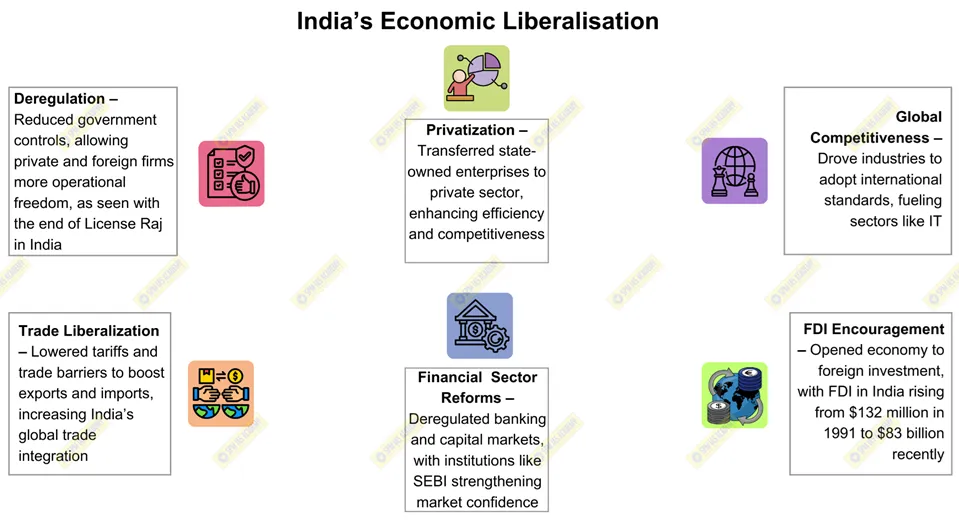Economic liberalization, introduced in India in 1991, marked a paradigm shift from a closed, state-controlled economy to an open, market-driven one. This reform aimed to dismantle trade barriers, reduce government intervention, and attract foreign investment, thereby catalyzing economic growth. Over the past few decades, liberalization has had a transformative impact on India’s economic landscape, contributing to a rise in GDP, increased foreign capital inflows, and growth in various industries. Here are five key reasons linking economic liberalization with economic growth in India.
1. Increased Foreign Investment and Capital Inflows
Liberalization opened India’s doors to Foreign Direct Investment (FDI) and Foreign Portfolio Investment (FPI), driving growth in capital-intensive sectors like infrastructure, telecommunications, and manufacturing. Between 1991 and 2022, FDI inflows surged from $132 million to over $83 billion annually. Policies like Make in India and Production-Linked Incentives (PLI) further attract investments, creating jobs and bolstering economic output.

2. Enhanced Competitiveness and Innovation
Liberalization exposed Indian industries to global competition, pushing companies to innovate, reduce costs, and improve quality. Infosys, TCS, and Wipro emerged as global leaders in IT, a sector which alone contributes around 7.4% of India’s GDP and employs 4.5 million people. Open markets encourage private players to adopt global standards, fostering a competitive business environment that supports sustained growth.
3. Expansion of Exports and Trade
By lowering tariffs and eliminating quotas, India’s share in global trade improved significantly. Merchandise exports rose from $18 billion in 1991 to $422 billion in 2022, with services like IT further boosting export earnings. Liberalization led to free trade agreements and strengthened India’s trade position globally, enhancing foreign exchange reserves and reducing dependence on imports in various sectors.
4. Boost to Industrial and Service Sectors
Liberalization policies reduced licensing requirements, deregulated industries, and incentivized private and foreign players. This facilitated the growth of industries like automobile manufacturing, pharmaceuticals, and financial services. India’s service sector, now constituting 55% of the GDP, has become a major growth driver, supported by policies that encourage private participation in finance, telecommunications, and tourism.
5. Increased Employment and Poverty Reduction
Economic growth from liberalization has created millions of jobs, particularly in industries like IT, manufacturing, and services. Liberalization-induced growth has contributed to reducing poverty; World Bank data shows that poverty in India fell from 45% in 1993 to about 22% in 2011. Programs like Skill India and Digital India continue to leverage liberalization benefits, providing job skills that drive social mobility and income levels.
Economic liberalization has positively impacted India’s economic growth by attracting investment, promoting competitiveness, boosting exports, and creating jobs. These reforms have turned India into one of the world’s fastest-growing major economies, contributing to its rising global stature and economic resilience. As India moves toward its goal of becoming a $5 trillion economy, continued liberalization, supported by digital transformation and policy innovation, will be pivotal in sustaining growth and ensuring inclusive development.












